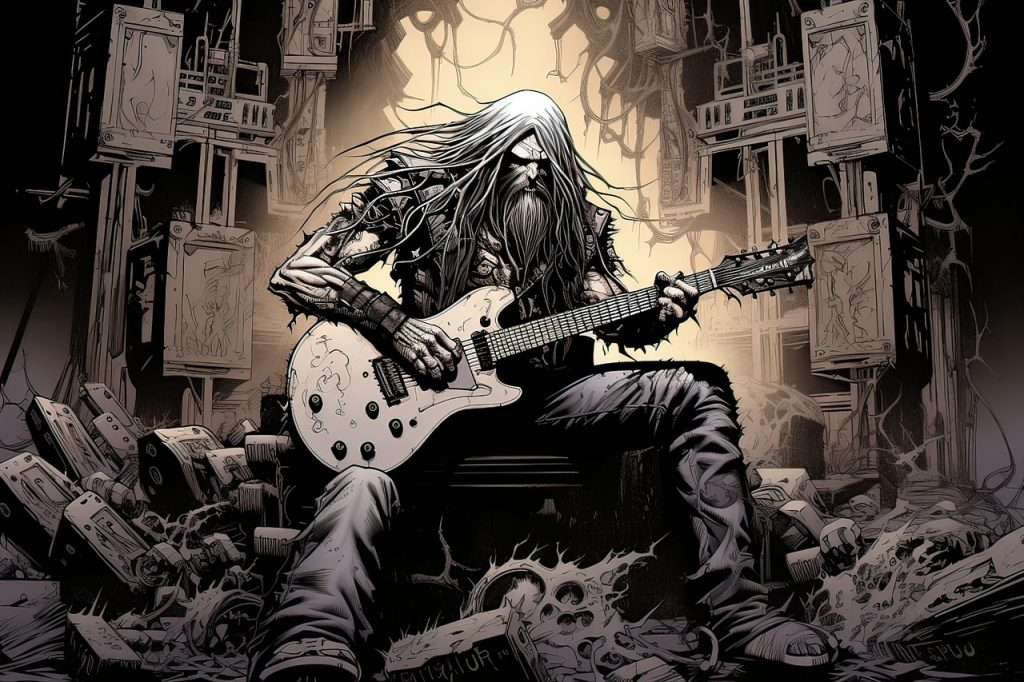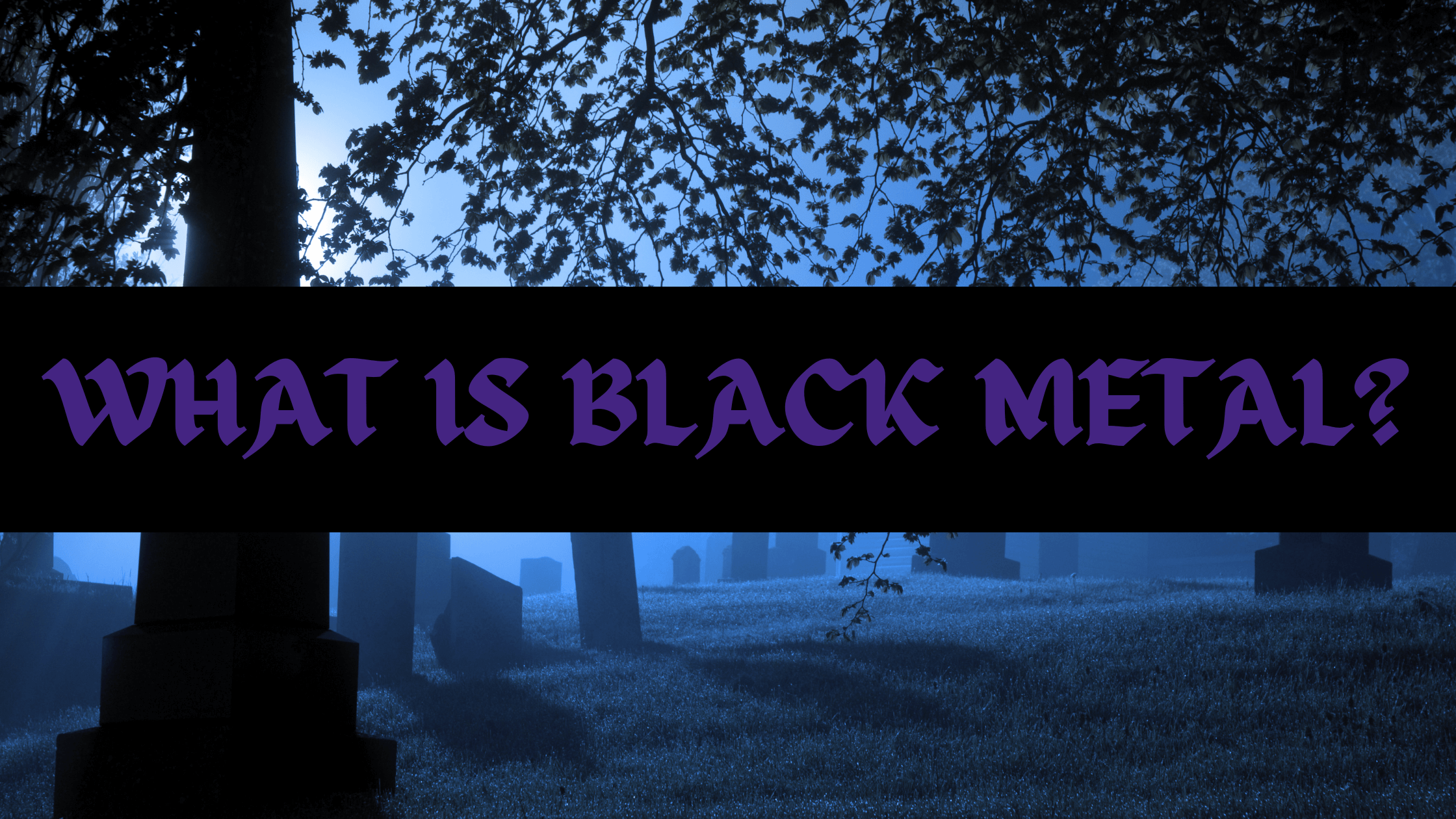Welcome to the enchanting world of black metal, a subgenre of heavy metal music that beckons to those who seek the raw, untamed, and hauntingly beautiful. In this guide, we’ll delve into the abyss of black metal, unraveling its enigmatic charm and unveiling its profound depths.
At its core, black metal is a subgenre like no other, celebrated for its distinct characteristics that set it apart in the realm of music. Brace yourself for an auditory journey characterized by an unrelenting and aggressive sound that pierces the soul. The cacophony of rapid tremolo-picked guitar riffs and thunderous blast beats is sure to captivate your senses.
But black metal is more than just a sonic assault. It weaves intricate tales of despair, nihilism, and the occult through its lyrics, often exploring dark and esoteric realms of human existence. Prepare to be immersed in lyrical themes that challenge conventional norms and delve into the depths of the human psyche.
Origins and History of Black Metal
1.1 Early Influences
Black metal, with its dark and aggressive sound, has roots that trace back to the early influences of bands like Venom and Bathory. These pioneers played a pivotal role in laying the groundwork for the genre’s development, even before the term “black metal” was widely used.
Venom, a British heavy metal band formed in 1978, is often regarded as the progenitor of black metal. Their 1982 album, “Black Metal,” not only gave the genre its name but also introduced elements that would become quintessential to black metal’s sonic palette. Venom’s aggressive and raw approach, along with their lyrical fascination with Satanism, occultism, and darkness, set a template for what would follow.
Bathory, a Swedish band led by Quorthon (Thomas Forsberg), emerged in the early 1980s. Their early releases, particularly the self-titled album “Bathory” (1984) and “The Return……” (1985), incorporated themes of Viking mythology and darkness. Bathory’s lo-fi production and eerie atmospheres were influential in shaping black metal’s musical style, emphasizing a DIY ethos that would persist within the genre.
1.2 First-Wave Black Metal
The first-wave of black metal, emerging in the early 1980s, was a crucible of experimentation. Bands like Hellhammer and Celtic Frost took the genre to new extremes, further refining its characteristics.
Hellhammer, a Swiss extreme metal band, formed in 1982, unleashed a raw and chaotic style that paved the way for black metal’s sonic aggression. Their infamous “Triumph of Death” demo (1983) showcased blistering guitar work, unconventional song structures, and a relentless drumming style that would later become staples of black metal.
Celtic Frost, another Swiss band, formed by former Hellhammer members, continued to explore the boundaries of heavy music. Their album “To Mega Therion” (1985) incorporated elements of classical music and avant-garde, adding an intellectual dimension to the burgeoning genre. Celtic Frost’s influence on black metal’s experimental side cannot be overstated.
1.3 Second-Wave Black Metal
The early 1990s saw the emergence of the second-wave black metal movement, primarily centered in Norway. This era marked a turning point in the genre’s history, both musically and culturally.
Key bands like Mayhem, Burzum, and Emperor spearheaded this movement. Mayhem, with their album “De Mysteriis Dom Sathanas” (1994), showcased a fusion of raw aggression and eerie atmospheres, solidifying black metal’s reputation for darkness and brutality.
Burzum, the one-man project of Varg Vikernes, is notorious not only for its music but also for Vikernes’s involvement in church burnings and the murder of Mayhem’s Euronymous. Despite the controversy, Burzum’s early releases, such as “Filosofem” (1996), contributed to black metal’s expansion into atmospheric and ambient territories.
Emperor, led by Ihsahn, presented a symphonic and grandiose side to black metal with their album “In the Nightside Eclipse” (1994). This release showcased the genre’s potential for epic and majestic compositions.
The infamous events of church burnings and murders in Norway during this era shocked the world and added an aura of darkness and controversy to black metal that still lingers today. These incidents, though not representative of the entire genre, are significant chapters in its history.
The early influences, first-wave pioneers, and the explosive emergence of the second wave of black metal all played crucial roles in shaping the genre’s distinctive sound and aesthetics. The journey of black metal was just beginning, with more chapters yet to be written in its dark and tumultuous history.
Musical Characteristics of Black Metal
2.1 Distinctive Sound
When you step into the world of black metal, the first thing that engulfs you is its distinctive and relentless sound. It’s a sonic storm that leaves an indelible mark on your psyche. Let’s dissect the key elements that constitute the heart and soul of black metal’s auditory landscape.
Tremolo-Picked Guitar Riffs: Black metal guitarists are known for their frenetic use of tremolo picking. This technique involves rapidly alternating between two notes, creating an eerie and buzzing sound. This sonic assault of tremolo-picked guitar riffs is like a swarm of angry hornets, filling the air with a disorienting and hypnotic quality.
Blast Beats: The percussion in black metal is marked by blast beats, a drumming style that pushes the boundaries of speed and aggression. With relentless double-bass pedal attacks and lightning-fast snare hits, blast beats are the engine that propels black metal’s furious energy.
Shrieking Vocals: The vocals in black metal are far from the traditional melodic singing you might expect. Instead, they often consist of high-pitched shrieks and screams. These unearthly vocalizations, filled with anguish and despair, add an extra layer of intensity to the music.
Creating Darkness and Aggression: The combination of these elements forms an atmosphere of darkness and aggression that is unique to black metal. It’s a sound that conjures images of desolate landscapes, ancient forests, and otherworldly realms. Black metal is not just music; it’s an auditory journey into the abyss of human emotions.
2.2 Lyrical Themes
Black metal’s lyrical themes are a window into the darkest corners of the human psyche. They explore the depths of existential despair, hatred, and a fascination with the occult. Here are some common lyrical themes you’ll encounter in black metal:
Nihilism: Black metal often delves into the concept of nihilism, the belief in the meaninglessness of existence. Lyrics may express a sense of futility and hopelessness, reflecting a world devoid of purpose.
Example Lyrics: “Life is a prison, life is a cell. Life is a sentence in an earthly hell.” (Darkthrone – “Lifeless”)
Misanthropy: Many black metal songs harbor a deep-seated misanthropy, a profound distrust and contempt for humanity. The lyrics often express a desire for solitude and an escape from the corrupting influence of society.
Example Lyrics: “Hate is the only law, and wrath the only rule.” (Emperor – “I Am the Black Wizards”)
Nature: Nature is a recurring theme in black metal, often portrayed as a mystical and untamed force. Lyrics may evoke images of vast forests, towering mountains, and the beauty of the natural world.
Example Lyrics: “In the arms of Mother Nature, I’m swept away.” (Agalloch – “In the Shadow of Our Pale Companion”)
The Occult: Black metal has a fascination with the occult, with lyrics delving into themes of witchcraft, Satanism, and esoteric knowledge. These lyrics create an aura of mystery and intrigue.
Example Lyrics: “Hail Satan, archangelo! Hail Satan, welcome year zero!” (Ghost – “Year Zero”)
2.3 Visual Aesthetics
Visual aesthetics play a pivotal role in black metal, helping to craft its enigmatic and dark image. These elements are carefully designed to immerse the audience in a world of mystique and foreboding.
Band Logos: Black metal bands often have intricate and cryptic logos. These logos can be almost illegible, adding an element of mystery. The unreadable nature of these logos forces fans to delve deeper, seeking to decipher their meaning.
Album Artwork: Album artwork in black metal is a canvas for conveying the essence of the music. It frequently features dark and haunting imagery, from desolate landscapes to occult symbols. These visuals provide a glimpse into the emotional landscape of the music.
Stage Attire: When performing live, black metal musicians don’t just wear ordinary clothes. They don the iconic “corpse paint,” transforming themselves into otherworldly beings. This makeup, with its stark contrasts and eerie designs, creates a sense of detachment from the everyday world.
Mysterious and Dark Image: The importance of these visual aesthetics lies in their ability to create a mysterious and dark image for the genre. Black metal artists want their audience to feel like they’re stepping into a different realm, one where the boundaries between reality and fantasy blur.
In black metal, the music, lyrics, and visual aesthetics coalesce to form a holistic experience that transports the listener into a realm of darkness, emotion, and mystique. It’s a genre that goes beyond mere entertainment; it’s an exploration of the human psyche and the unknown.

Subgenres and Regional Variations
3.1 Subgenres of Black Metal
Black metal, like a chameleon, has adapted and evolved over the years, giving rise to a multitude of subgenres that both challenge and honor its core essence. Here, we journey into the diverse soundscapes that these subgenres create.
Atmospheric Black Metal: Atmospheric black metal subverts the genre’s traditional aggression for an ethereal and immersive experience. Bands like Wolves in the Throne Room use lush, expansive soundscapes, melodic guitar lines, and atmospheric textures to create an otherworldly journey. The essence of black metal remains, but it’s draped in a dreamlike shroud.
Symphonic Black Metal: Symphonic black metal marries the genre with orchestral elements, introducing choirs, symphonies, and grandeur. Bands like Dimmu Borgir embrace the theatrical and epic, using keyboards and orchestration to create a grandiose atmosphere. The result is a fusion of black metal’s darkness with the opulence of classical music.
Folk Black Metal: Folk black metal combines the primal roots of folk music with the aggression of black metal. Bands like Finntroll blend traditional folk instruments, such as the accordion and fiddle, with distorted guitars and harsh vocals. The result is a celebration of folklore and mysticism, wrapped in black metal’s embrace.
Each of these subgenres retains the core essence of black metal, which is a relentless exploration of the human condition, often shrouded in darkness. They serve as tributaries that flow from the same source, offering unique and captivating listening experiences.
3.2 Regional Variations
Black metal, born from the depths of Norway, has transcended borders to reach far-flung corners of the world. In each region, it takes on the flavors of local culture and history, shaping its sound and themes in unique ways.
Sweden: Sweden’s black metal scene has produced bands like Dissection, known for their melodic and technically proficient style. The Swedish landscape’s mystique and folklore often find their way into the music, creating a sense of ancient grandeur.
Finland: Finnish black metal, exemplified by bands like Horna, is often characterized by a raw and uncompromising sound. The harshness of the Finnish winters and the country’s folklore provide a dark and desolate backdrop.
Greece: Greece’s black metal scene, with bands like Rotting Christ, infuses Mediterranean mysticism into the genre. Ancient Greek mythology, philosophy, and occultism often inspire lyrical themes, creating a unique blend of darkness and spirituality.
United States: In the United States, bands like Agalloch embrace the vast landscapes of the Pacific Northwest, infusing their music with a sense of nature’s grandeur. The American black metal scene is diverse, with bands drawing inspiration from a wide range of influences.
These regional variations showcase the adaptability of black metal, proving that its essence can find resonance in the most unexpected places. Black metal is not confined by geography; instead, it thrives by absorbing the spirit of the land it touches. As you explore these regional scenes, you’ll discover the vast tapestry of stories and emotions that black metal weaves, each thread distinct yet connected by the genre’s enduring spirit.
CONCLUSION
In the dimly lit corridors of black metal, we’ve journeyed from its enigmatic origins to its diverse subgenres and global influence. We’ve felt the thunderous blast beats, heard the haunting shrieks, and delved into the abyss of its lyrical themes. From pioneers like Mayhem to contemporary innovators like Deafheaven, black metal’s evolution is a testament to its resilience and adaptability. As we conclude this beginner’s guide, remember that black metal is not just music; it’s a gateway to raw emotions, dark landscapes, and the exploration of the human psyche. So, embrace the darkness, and let the haunting melodies guide you on your own unique odyssey through the world of black metal.
RELATED BLACK METAL ARTICLES
- What is the best Amp for Black Metal: Read Here (Electric Guitar Review article)
- Key figures Black Metal: Read here;
- History of the first Black Metal Bands/Albums: Read here;
- History and iconic albums of Bathory, Legends of Viking Black Metal subgenre: Read here
- What is Symphonic Black Metal
- What is Industrial Black metal
- What is Atmospheric Black metal

